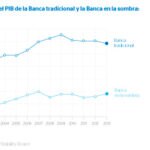The keys to shadow banking
P2P financial systems are becoming more common in our economy. For this reason, we would like to provide you with the six keys to a better understanding of shadow banking, as well as its strengths and weaknesses in comparison with traditional banking.

Shadow banking is controversial even in its definition. International experts cannot agree on the characteristics of this increasingly popular financial system, which involves financial activities outside the conventional framework.
For this reason, before we provide you with the keys to a better understanding of shadow banking, we would like to list three possible definitions for this system:
Financial Stability Board: Shadow banking is credit intermediation involving financial entities and activities outside the regular banking system.
Stijn Claessens and Lev Ratnovski: All financial activities, except traditional banking, which require a private or public backstop to operate.
Zoltan Pozsar: Entities that provide credit, maturity and liquidity transformation with no government backing or access to the central bank's liquidity.

Now that we have an idea of what this financial system refers to, we go on to list the six keys to understanding its strengths and weaknesses:
Where is it most common, and why?
The biggest shadow banking systems are located in advanced economies, in other words, in countries where there has been an economic standstill in recent years, and where regulatory measures are more clearly defined.
For this reason, the IMF suggests that the shadow system will continue to grow in these advanced economies because the ongoing "tightening of banking regulation" and an increase in investor demand lead to this type of activity (strictly speaking, non-banking activities).
However, the shadow banking system is growing steadily in emerging economies, surpassing traditional banking growth. This type of development is best exemplified by China: its government has applied severe restrictions to traditional banking, leading to the height of P2P and P2B financial activities.
A complement to traditional banking
There is no doubt about this: traditional banking and shadow banking can complement each other. In fact, the shadow system is beneficial: it expands credit access and, consequently, adds liquidity to the market, and results in the distribution of financial risks.
Potential growth of P2P loans
In the US and the UK, this type of activity is centered around households and SMEs, even though there are some associations between these platforms and a few traditional banks. According to IMF data, by late March 2014 this market handled more than 6.5 billion dollars.

The issue of transparency
The lack of transparency is one of the weaknesses of P2P financial activities. There are major gaps in information in this financial system; for this reason, many authorities (such as the IMF) argue that transparency should be ensured in order to improve information and encourage regulations that improve risk management. Currently, it is still very difficult to obtain measurable data about P2P activities, both in terms of donations and shadow loans and investments.
The risks
In late 2013 shadow banking accounted for 30% of all systemic risk in the US banking sector. But this figure was much lower in the eurozone and the UK – 13% and 7% respectively.
To stop this risk from increasing as this type of activity grows, the IMF insists that strong international political cooperation is necessary to achieve cross-border regulatory arbitration. This would make it possible to face the risks and attain global financial stability.
In fact, risks tend to increase when regulatory measures are implemented without inter-country coordination: regulatory changes in one country may result in secondary effects and increased risks in another country.
The specific risks of shadow banking can be mitigated by using tools such as limiting reimbursement in collective investment or restricting investment leveraging. Additionally, it is also necessary to expand information requirements with a view to increasing system transparency and allowing risk tracking.
Regulatory objectives
Authorities face the challenge of maximizing the economic benefits of shadow banking and reducing its systemic risks. It is necessary to reach a balance between the advantages of this system and traditional economic funding, while increasing the protection against the system's weaknesses. Diverse country regulations lead to a company being considered a bank in one country and a shadow bank in another. For this reason, the IMF suggests that political frameworks be established that identify and respond to the threats against financial stability; this type of framework has increased since the global financial crisis.
In fact, the IMF recommends that banking entities and shadow entities be distinguished by activities, function and level of risk.
Lastly, the IMF suggests four stages for a regulatory response to shadow banking:
- Systemically identify risks based on broad supervision of the financial sector by a macroprudential authority.
- Consider and potentially adopt political measures, which include macroprudential measures, changes in business behavior and non-regulatory measures.
- Supervise and implement these measures, based on the experience of microprudential authorities.
- Evaluate the effectiveness of the above-mentioned political and economic measures at least once a year, and report the results internationally.